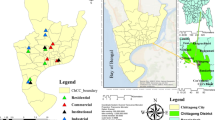Abstract
Accurate knowledge of the quality and environmental impact of the highway runoff in Pear River Delta, South China is required to assess this important non-point pollution source. This paper presents the quality characterization and environmental impact assessment of rainfall runoff from highways in urban and rural area of Guangzhou, the largest city of Pear River Delta over 1 year’s investigation. Multiple regression and Pearson correlation analysis were used to determine influence of the rainfall characteristics on water quality and correlations among the constituents in highway runoff. The results and analysis indicates that the runoff water is nearly neutral with low biodegradability. Oil and grease (O&G), suspended solids (SS) and heavy metals are the dominant pollutants in contrast to the low level of nutrient constituents in runoff. Quality of highway runoff at rural site is better than that of at urban site for most constituents. Depth and antecedent dry period are the main rainfall factors influencing quality of highway runoff. The correlation patterns among constituents in highway runoff at urban site are consistent with their dominant phases in water. Strong correlations (r ≥ 0.80) are found among chemical oxygen demand (COD), total phosphorus, Cu and Zn as well as conductivity, nitrate nitrogen and total nitrogen. O&G, COD, SS and Pb in highway runoff at urban site substantially exceed their concentrations in receiving water of Pear River. The soil directly discharged by highway runoff at rural site has contaminated seriously by heavy metals in surface layer accompanying with pH conversion from original acidic to alkaline at present.
Similar content being viewed by others
References
Barrett, M. E., Irish, L. B. Jr., Malina, J. F. Jr., & Charbeneau, R. J. (1998). Characterization of highway runoff in Austin, Texas, area. Journal of Environmental Engineering, 124, 131–137.
Charbeneau, R. J., & Barrett, M. E. (1998). Evaluation of methods for estimating stormwater pollutant loads. Water Environment Research, 70, 1295–1302.
China’s State Environment Protection Agency. (Eds.) (2002). Water and waste water monitoring and analysis methods. Beijing, China: China Environmental Science Press.
Drapper, D., & Tomlinson, R. (2000). Pollutant concentrations in road runoff: Southeast Queensland case study. Journal of Environmental Engineering, 126, 313–319.
Hallberg, M., Renman, G., & Lundbom, T. (2006). Seasonal variations of ten metals in highway runoff and their partition between dissolved and particulate matter. Water, Air, & Soil Pollution (in press). doi:10.1007/s11270-006-9289-5.
Han, Y. H., Lau, S. L., Kayhanian, M., & Stenstrom, M. K. (2006). Correlation analysis among highway stormwater pollutants and characteristics. Water Science and Technology, 53, 235–243.
Kayhanian, M., Singh, A., Suverkropp, C., & Borroum, S. (2003). Impact of annual average daily traffic on highway runoff pollutant concentrations. Journal of Environmental Engineering, 129, 975–990.
Kim, L. H., Kayhanian, M., Zoh, K. D., & Stenstrom, M. K. (2005). Modeling of highway stormwater runoff. Science of the Total Environment, 348, 1–18.
Kim, L. H., Zoh, K. D., Jeong, S. M., Kayhanian, M., & Stenstrom, M. K. (2006). Estimating pollutant mass accumulation on highways during dry periods. Journal of Environmental Engineering, 132, 985–993.
Lee, B. C., Matsui, S., Shimizu, Y., Matsuda, T., & Tanaka, Y. (2005). A new installation for treatment of road runoff: Up-flow filtration by porous polypropylene media. Water Science and Technology, 52, 225–232.
Legret, M., & Pagotto, C. (1999). Evaluation of pollutant loadings in the runoff waters from a major rural highway. Science of the Total Environment, 235, 143–150.
Leitao, T. E. (2005). Impact of road runoff in soil and groundwater. Synthesis of Portuguese and other European case-studies. Paper presented at the 4th Inter-Celtic Colloquium on Hydrology and Management of Water Resources, Guimarães, Portugal (July).
Li, Y., Lau, S. L., Kayhanian, M., & Stenstrom, M. K. (2005). Particle size distribution in highway runoff. Journal of Environmental Engineering, 131, 1267–1276.
Mangani, G., Berloni, A., Bellucci, F., Tatàno, F., & Maione, M. (2005). Evaluation of the pollutant content in road runoff first flush waters. Water, Air & Soil Pollution, 160, 213–228.
Pagotto, C., Legret, M., & Le Cloirec, P. (2000). Comparison of the hydraulic behaviour and the quality of highway runoff water according to the type of pavement. Water Research, 34, 4446–4454.
Sansalone, J. J., & Buchberger, S. G. (1997). Partitioning and first flush of metals in urban roadway storm water. Journal of Environmental Engineering, 123, 134–143.
Stenstrom, M. K., & Kayhanian, M. (2005). First flush phenomenon characterization. Report, CTSW-RT-05-73-02.6 (1–69). Sacramento, CA: California Department of Transportation, Division of Environmental Analysis.
Thomson, N. R., McBean1, E. A., Snodgrass, W., & Monstrenko, I. B. (1997). Highway stormwater runoff quality: Development of surrogate parameter relationships. Water, Air & Soil Pollution, 94, 307–347.
Vaze, J., & Chiew, F. H. S. (2003). Study of pollutant washoff from small impervious experimental plots. Water Resources Research, 39, 1160–1169.
Wu, J. S., Allan, C. J., Saunders, W. L., & Evett, J. B. (1998). Characterization and pollutant loading estimation for highway runoff. Journal of Environmental Engineering, 124, 584–592.
Zhang, S., Yao, W., & Lv, X. (2002). Water quality analysis of urban highway runoff in Beijing. Paper presented at the International Symposium on Rainwater and Water Recycling, Beijing, China (September).
Zhao, J., Liu, S., Qiu, L., & Ying, C. (2001). The characteristics of expressway runoff quality and pollutants discharge rule. China Environmental Science, 21, 445–448.
Zhao, J. Q., Yu, Y., & Yuan, W. N. (2004). Water quality of storm runoff from an urban highway. In: Proceedings of the 8th International Conference on Urban Storm Drainage, Sydney, Australia (August).
Author information
Authors and Affiliations
Corresponding author
Rights and permissions
About this article
Cite this article
Gan, H., Zhuo, M., Li, D. et al. Quality characterization and impact assessment of highway runoff in urban and rural area of Guangzhou, China. Environ Monit Assess 140, 147–159 (2008). https://doi.org/10.1007/s10661-007-9856-2
Received:
Accepted:
Published:
Issue Date:
DOI: https://doi.org/10.1007/s10661-007-9856-2




